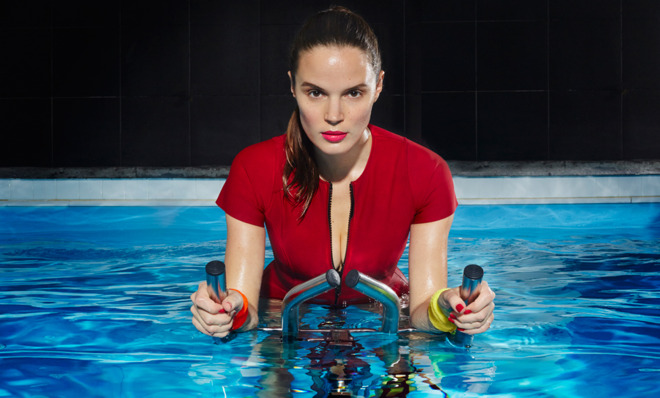What I learned from taking an aquacycling class
It's easy on your knees. Maybe too easy.

The instructor helped us all get situated on our bicycles. I started pedaling. Music blared. It was just like a normal spin class... except I was in the pool.
Aquacycling is basically what it sounds like — an exercise regiment that combines bicycling and swimming for a total body workout. Instructors say it burns between 600 and 800 calories per 45-minute session and reduces cellulite without stressing the joints and muscles. Invented by an Italian physical therapist to help injured athletes, aquacycling has been available in gyms in France and Italy for years. Last year, the idea pedaled its way across the pond to New York City, where America's first underwater cycling studio, AQUA, opened.
Aquacycling is easy on the joints because in water a person's weight is one fifth what it is on land. However, exercises in water can still increase muscle strength and endurance due to water's built-in resistance.
The Week
Escape your echo chamber. Get the facts behind the news, plus analysis from multiple perspectives.

Sign up for The Week's Free Newsletters
From our morning news briefing to a weekly Good News Newsletter, get the best of The Week delivered directly to your inbox.
From our morning news briefing to a weekly Good News Newsletter, get the best of The Week delivered directly to your inbox.
"It's an intense and high-performance workout, but at the same time gentler than any other workout," said Esther Gauthier, owner of AQUA.

Aquacycling is particularly helpful for overweight or obese people who may find it difficult to do manage joint-demanding aerobic exercises, says Dr. John P. Higgins, director of exercise physiology at Memorial Hermann Ironman Sports Medicine Institute in Houston.
"It's a nice niche for those people who want to do aerobics, but doing it the other way is painful," he said.
As for claims that aquacycling (or any type of exercise for that matter) can burn cellulite, though — the jury's still out. Some doctors say cellulite is based on genetics and nothing can be done to combat it, while others think that steps can be taken to at least temporarily reduce the appearance of dimply thighs. Higgins said that applying heat and pressure to cellulite, as occurs from the movements in the water during aquacycling, could act as a vigorous massage to help reduce the appearance of cellulite.
A free daily email with the biggest news stories of the day – and the best features from TheWeek.com
In my aquacycling class, the instructor encouraged us to pedal faster as waves lapped up around the pool. I could feel the resistance pushing against my legs as they churned through the water. For the first 15 minutes we worked through a series of pedaling as fast we could, and then slowing down to a normal pace. Tiny whirlpools of water swirled by my body, pressing against my legs as if they were jelly. The cycle was repeated a couple more times, and each time, we moved the position of our hands to work different muscles in our legs. To exercise our arms, we performed a series of one-armed freestyle strokes while continuing to pedal. I could really feel it in my shoulders, and judging by the strained looks on the faces of my classmates, they felt it as well.
After a short break of cycling at a comfortable pace, we lifted our bodies out of the saddle and repositioned ourselves behind the bike to tread water while still pedaling. It was weird. But I could also feel it working my abs and arms as I struggled to stay afloat. The instructor counted down reps from five to one. Then it was back on the bike for more pedaling and a cool-down where we stretched out all of the muscles we had worked. I didn't break a sweat once, but that could have been the result of working out in a pool.
In the end, though, it really wasn't that hard. One of my fellow aquacyclists noted to me, "It didn't even feel like I was exercising!" And that troubled me. How good of a workout was this? By the time my class was done I had gotten my heart rate up to about 130 bpm (I normally aim for 170) and the next day I didn't feel any soreness or fatigue in my muscles. I shared this with Dr. Higgins.
"Before making any conclusions they need to do more research and good studies [on aquacycling] to see which groups stand to gain the most and how to incorporate this into an overall fitness program," he said. Higgins said that the American College of Sports Medicine recommends a mixture of aerobic and resistance training for optimal health. "Aquacycling is good as a part of your fitness program, not the whole thing."
And that's the thing. I can see how aquacycling might help injured athletes or obese Americans. I can see how it might be a good light workout for a fitness freak to slot between heavier workouts. But as the core of a fitness program? No way. Swimming is great for you. So is biking. But combining them? Let's just say aquacycling is a whole that fails to be greater than the sum of its parts.
Amy Kraft is a print and radio reporter based in New York. She reports on science and the environment for publications including Scientific American, Discover, Popular Science, Psychology Today, and Distillations, a podcast out of the Chemical Heritage Foundation. She is currently working on a book of humor essays. You can check out more of her writing on her blog Jaded Bride.
-
 The week’s best photos
The week’s best photosIn Pictures A man's best friend, the elephants in the room, and more
-
 A TikTok trend has Gen Z men leaving streetwear behind for more preppy attire
A TikTok trend has Gen Z men leaving streetwear behind for more preppy attireThe Explainer More than a zipper: Young Black men embrace the ‘quarter-zip movement‘
-
 Sudoku hard: December 12, 2025
Sudoku hard: December 12, 2025The daily hard sudoku puzzle from The Week